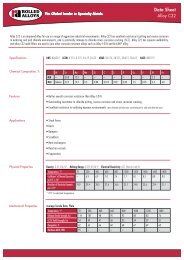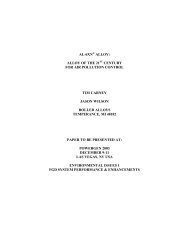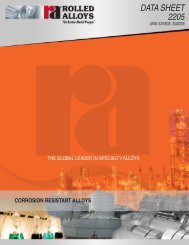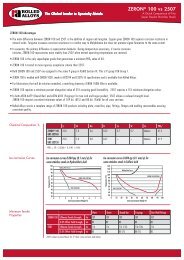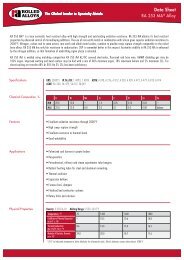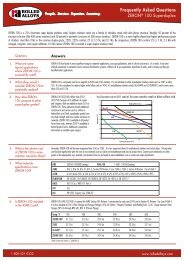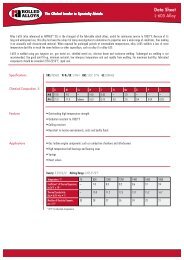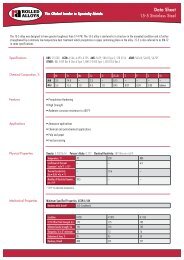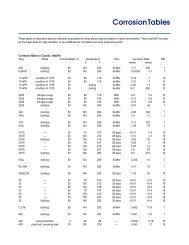Field Experiences and Fabrication Techniques ... - Rolled Alloys
Field Experiences and Fabrication Techniques ... - Rolled Alloys
Field Experiences and Fabrication Techniques ... - Rolled Alloys
Create successful ePaper yourself
Turn your PDF publications into a flip-book with our unique Google optimized e-Paper software.
<strong>Field</strong> <strong>Experiences</strong> <strong>and</strong> <strong>Fabrication</strong> <strong>Techniques</strong> related to AL-6XN Alloy for SWROApplicationsAuthors:Jason Wilson <strong>and</strong> John Thackray, <strong>Rolled</strong> <strong>Alloys</strong>, Temperance, Michigan, USAPresenter: Jason Wilson, Technical Marketing Manager, <strong>Rolled</strong> <strong>Alloys</strong>, USAAbstractFailure of metallic components in desalination plants results in forced shut down <strong>and</strong> loss in production.The failure of material is caused of localized corrosion, stresses, dissimilar metal combination orenvironmental attack. A proper material selection is the key to minimize the chances of corrosion ofmaterial <strong>and</strong> provide longevity to the plant. Superb corrosion resistance, good mechanical properties <strong>and</strong>cost effectiveness are the virtues of an excellent material selection.Super Austenitic Stainless Steels or 6% molybdenum stainless steels, like AL-6XN, are heavily used forhigh pressure feed pipe systems in SWRO plants. AL-6XN alloy was designed to be a seawater resistantalloy <strong>and</strong> has been successfully used in a multitude of marine <strong>and</strong> offshore applications includingprocess piping systems, heat exchanger equipment, drilling platforms, <strong>and</strong> desalination systems.Additionally, AL-6XN alloy has also been utilized for brine concentrators, wastewater evaporators,which contain similarly high chloride levels.Alloying with 6.2 percent molybdenum, 20.5 percent chromium, 0.22 percent nitrogen provides a highlevel of resistance to localized corrosion by halides. As a result, AL-6XN can tolerate much moresevere levels of chlorides than st<strong>and</strong>ard austenitic or duplex stainless steels without the onset of pittingor crevice corrosion. The combination of 24 percent nickel content <strong>and</strong> a nitrogen addition provide AL-6XN with its good welding <strong>and</strong> forming characteristics, which are superior to duplex <strong>and</strong> ferriticstainless steels of comparable corrosion resistance.The corrosion resistance of AL-6XN in seawater service will be reviewed along with comparisons toother grades commonly used in SWRO applications. This includes the austenitic, duplex, <strong>and</strong> superduplex stainless steels. Various case studies are presented where AL-6XN has been successfully used inSWRO facilities <strong>and</strong> other related applications. Also, presented are cases where AL-6XN hassuccessfully replaced SWRO equipment originally fabricated in other grades of stainless steel thatsuffered corrosion failures.In addition to in service performance, fabrication practices <strong>and</strong> procedures are also discussed includingwelding, forming, <strong>and</strong> machining.International Desalination Association World Congress REF: DB09-034-1-
I. INTRODUCTIONThe corrosion resistance of stainless steels makes them well suited for use in water treatment systemsusing reverse osmosis. Reverse osmosis systems are widely used for fresh water production for humanconsumption. While 316L stainless is useful for waters containing low levels of chlorides, its alloycontent is insufficient to resist localized corrosion in waters containing elevated levels of chlorides suchas seawater. Materials containing greater levels of chromium <strong>and</strong> molybdenum are necessary to resistlocalized attack in seawater systems, especially under crevice conditions. As a result, higher alloyedsuper austenitic stainless steels have been increasingly used to replace existing equipment <strong>and</strong> have beenused as a st<strong>and</strong>ard alloy of construction for many components of SWRO equipment.1.1 AL-6XN® Alloy (UNS N08367)AL-6XN® alloy (UNS N08367) is a low carbon, high purity, nitrogen-bearing "super-austenitic"stainless alloy. The AL-6XN alloy was designed to be a seawater resistant material <strong>and</strong> has since beendemonstrated to be resistant to a broad range of very corrosive environments. The high strength <strong>and</strong>corrosion resistance of the AL-6XN alloy make it a better choice than the conventional duplex stainlesssteels <strong>and</strong> a cost effective alternative to more expensive nickel-base alloys in applications whereexcellent formability, weldability, strength <strong>and</strong> corrosion resistance are essential. It is also a costeffectivealternative to less expensive alloys, such as Type 316, that do not have the strength orcorrosion resistance required to minimize life cycle costs in certain applications. The high nickel <strong>and</strong>molybdenum contents provide improved resistance to chloride stress-corrosion cracking. Copper (Cu)has been intentionally kept to a residual level for improved performance in seawater. The high alloycomposition of the AL-6XN alloy resists crevice corrosion <strong>and</strong> pitting in oxidizing chloride solutions toa degree previously achieved only by nickel-base alloys <strong>and</strong> titanium.II.CORROSION RESISTANCE2.1 Chemical Compositions & Laboratory TestingThe corrosion resistance has been reviewed in many papers published previously about AL-6XN alloy.It is widely accepted that increasing chromium, molybdenum, <strong>and</strong> nitrogen are beneficial in improvinglocalized corrosion resistance in seawater. Table 1 provides the nominal chemistries of severalaustenitic <strong>and</strong> duplex, <strong>and</strong> super duplex (SDSS) stainless steels commonly used in water treatmentsystems. Rankings according to each materials pitting resistance equivalent (PREn) <strong>and</strong> critical pittingtemperature (CPT) in the ASTM G 150 test in 1 M NaCl solutions are also provided. The PREn value iscalculated using the following formula: PREn = % chromium + 3.3 x % molybdenum + 16 x % nitrogenTable 1 – Nominal Chemistries & PREn values for Various Stainless SteelsUNSNumberCommonNameNi Cr Mo N Other PREn CPT°FS31603 316L 10.2 16.4 2.1 - 0.02 C 24 68S32205 2205 5.6 22.1 3.1 0.16 0.02 C 35 120S31803S32750 2507 7 25 4 0.27 0.02 C 42 180N08904 904L 24 20.5 4.5 - 36 130N08367 AL-6XN 24 20.5 6.2 0.22 0.02 C 44 172International Desalination Association World Congress REF: DB09-034-2-
2.2 Arabian Gulf TestingThe Saline Water Conversion Corporation, SWCC, conducted tests, on AL-6XN alloy in Arabian Gulfseawater <strong>and</strong> seawater concentrate (Al-Jubail RO reject brine) [1]. For comparison purposes, the 316Lstainless steel was also tested under identical conditions. This corrosion performance evaluation of AL-6XN alloy was done employing immersion <strong>and</strong> electrochemical testing. During immersion tests understatic conditions, the AL-6XN alloy did not show any perceptible weight change after a period of oneyear. Under dynamic conditions, samples exposed in a laboratory test loop for 30 days did not show anyappreciable weight loss. The AL-6XN alloy exhibited high pitting resistance in potentiodynamic cyclicpolarization tests. Tests in seawater <strong>and</strong> RO reject brine yielded Epit of 1070 <strong>and</strong> 1058 mV, respectively,shown in Figures 1 <strong>and</strong> 2. Results from potentiostatic experiments show similar trends.Figure 1 Polarization curves for AL-6XN <strong>and</strong> 316L in seawaterFigure 2 Polarization curves for AL-6XN <strong>and</strong> 316L in RO reject waterInternational Desalination Association World Congress REF: DB09-034-3-
Crevice corrosion tests (CCT) carried out on plain alloy specimens in seawater <strong>and</strong> RO reject, usingmultiple crevice assemblies, showed no effect in both the media even after six months exposure.Autogenous welded samples of AL-6XN show weight losses of only seven <strong>and</strong> nine milligrams undertorques of five <strong>and</strong> ten foot-pounds after six months of exposure indicating extremely high resistance tocorrosion.III.SERVICE EXPERIENCE3.1 Tampa Bay [2]A reverse osmosis (RO) seawater desalination plant was built to help the Tampa, Florida area meet itswater needs. Tampa Bay Water owns <strong>and</strong> operates the USA’s largest desalination plant, which is rated at25 MGD. The project started to operate at the end of 2002. The salinity of the source water fromTampa Bay ranges from 16-34 ppt on average. The temperature of the water from the power plantcooling water discharge to the RO pretreatment ranged from 98-105 °F.Figure 3 Filter Vessel constructed using AL-6XN MaterialDue to the pressure <strong>and</strong> the water's corrosiveness, AL-6XN alloy is used in critical locations throughoutthe pretreatment <strong>and</strong> reverse-osmosis processes to help to fight the corrosive effects of the seawater.The cartridge filter vessels, shown in Figure 3, <strong>and</strong> the high pressure piping on the RO skids wereconstructed of AL6XN. This materials selection is based upon the 30-year design life for the plant. Todate, the AL-6XN components of the plant have shown no corrosion.3.2 TrinidadThe largest RO seawater desalination plant in the Western Hemisphere was constructed in Trinidad. Theplant was designed to produce 109,000 cubic meters of water per day (28.8 million gallons a day) for theWater <strong>and</strong> Sewerage Authority of Trinidad <strong>and</strong> Tobago. AL-6XN pipe was chosen for the criticalpretreatment piping in this plant [3]. This project began operation at the end of 2002. Shortly afterstartup, localized corrosion was encountered under the gaskets in a significant fraction of thecompression couplings. The cause of this never was disclosed publicly but tacitly was attributed tostartup issues. The replacement pipes were also fabricated from AL-6XN material. Subsequently, AL-International Desalination Association World Congress REF: DB09-034-4-
6XN material was also chosen for an expansion that raised the output of this plant to approximately 40million gallons per day.3.3 Bahamas DesalinationWaterfields Company Limited operates a seawater RO plant that produces 2.64 million gallon per dayfor Nassau, Bahamas. The plant provides 20% of Nassau’s fresh water needs. This plant startedoperation in 1997. Seawater feed is extracted from wells <strong>and</strong> contains 39,000 ppm total dissolved solids.Initially, the plant was constructed using 316L stainless. Some 316L stainless components failed bypitting within six months, <strong>and</strong> were replaced with AL-6XN material in 1997. The AL-6XN material hasbeen in service since then with no reported failures.3.4 Affordable Desalination CollaborationThe ADC was formed in 2004 with its charter being to demonstrate that SWRO was economicallycompetitive with other means of supplying fresh water to Southern California. <strong>Rolled</strong> <strong>Alloys</strong> was aninitial member of the ADC along other notable companies such as Poseidon Resources, EnergyRecovery Inc., Carollo Engineers, Pentaire, <strong>and</strong> Piedmont Pacific. In addition, several governmentagencies were also members. <strong>Rolled</strong> <strong>Alloys</strong> supplied AL-6XN pipe <strong>and</strong> fittings for the ADC facility[4], which is located at Port Hueneme, California. This material was used in the high-pressure seawaterintake lines <strong>and</strong> the brine discharge lines.The tests results gathered, after years of operation, proved that SWRO was indeed cost effective withpumping Colorado River water from Nevada to Los Angeles. The AL-6XN material was chosen for thisapplication for its outst<strong>and</strong>ing corrosion resistance <strong>and</strong> proven record in seawater service. It hasoperated performed without issue.3.5 Florida Keys Aquaduct Authority – Stock Isl<strong>and</strong>This is a 2.18 MGD (8,252 m3/d) Stock Isl<strong>and</strong> Plant. The system operates at 35-40% recovery <strong>and</strong> each0.5 MGD (1,892 m3/d) train is equipped with a 650 HP (485 kW) diesel driven, multistage verticalturbine pump to provide 850 to 1000 psi (59 to 69 bar) operating pressure. Each SWRO train has areverse running energy recovery turbine to recover 200 HP (150 kW), <strong>and</strong> the total diesel fuelconsumption is 1.39g/kgal (1.39L/m 3 ).Harn R/O recently made some additional modifications including the replacement of the feed, permeate<strong>and</strong> concentrate lines with higher performance materials; the feed <strong>and</strong> concentrate lines were made fromAL6XN alloy [5].International Desalination Association World Congress REF: DB09-034-5-
Figure 4 Brine Discharge Piping Using AL-6XN pipe3.6 St. KittsA 1.25 million gallon per day reverse osmosis desalination plant was installed at the Marriott St. KittsRoyal Beach Resort & Spa. The plant was installed to provide potable <strong>and</strong> irrigation water for the 648room resort <strong>and</strong> its eighteen hole golf club. The plant design utilized four trains each rated for 250,000gallons per day with the option to add a fifth train. AL-6XN alloy was utilized for all of the highpressurepiping. The plant started full production in February 2004. No corrosion issues with the AL-6XN piping have been experienced.3.7 Carlsbad, CA Demonstration PlantPoseidon Resources operates a SWRO pilot plant at the site of Southern California Edison’s CarlsbadPower Station. This plant was initially fitted with a type 316L stainless piping system. Within sixmonths of start up the 316L material began to experience corrosion failures. The piping system wasreplaced in 2004 with AL-6XN being selected as the replacement material. Its selection based largelyon its extensive use in Poseidon’s Tampa Bay Desalination Plant. The AL-6XN material has been incontinuous use at Carlsbad since 2004, without any service issues.IV.FABRICATION4.1 <strong>Fabrication</strong> BackgroundWhile material selection is important, of equal importance is the use of correct weld filler metals <strong>and</strong>fabrication techniques to construct the equipment. Overall the procedures for fabricating AL-6XN arequite similar to those used on 300 series austenitic stainless steels. There are some differences thatshould be understood, however, to ensure a quality fabrication <strong>and</strong> avoid unnecessary added costs <strong>and</strong>delays during fabrication.International Desalination Association World Congress REF: DB09-034-6-
4.2 Welding4.2.1 Filler MetalsWelding without fillers over alloyed in molybdenum, can lead to microsegregation of Cr <strong>and</strong> Mo in theweld bead. This can result in reduced corrosion resistance. Autogenous welds in 6% molybdenumstainless steels have greatly reduced pitting corrosion resistance when compared to the base metal.Autogenously welded 6% molybdenum stainless steels have comparable corrosion resistance as a 4.5%molybdenum grade such as type 904L in laboratory testing. The sample coupon shown in Figure 5 wasconstructed of AL-6XN <strong>and</strong> S31254 coupons welded via gas tungsten arc welding (GTAW) autogenouslyon one side <strong>and</strong> with 625 filler on the other. Testing in accordance with ASTM G 48 for 72 hours was thenperformed on the specimen in the 10% FeCl 3 •6H 2 O solution at 50°C (122°F).Figure 5 Sample condition after corrosion testing for 72 hours in 10% FeCl 3 •6H 2 O, at 50°C (122°F). Theautogenous weld is shown at left <strong>and</strong> the GTAW weld with 625 filler is at right.AL-6XN must be welded with over alloyed filler metal for best corrosion resistance. To compensate forthe segregation of molybdenum <strong>and</strong> chromium, use of a weld filler such as 625 (ERNiCrMo-3) wire or 112(ENiCrMo-3) electrodes with nine percent molybdenum is common. It is also acceptable to use evenhigher molybdenum fillers such as alloy 22 (EniCrMo-10) to weld AL-6XN. Such fillers with greater than13.5% molybdenum provide additional corrosion resistance in the weld. The lower chromium alloy C-276(ERNiCrMo-4 wire) is not suggested for welding AL-6XN. C-276 weld filler does not match thechromium content of the AL-6XN alloy base metal.Welding of AL-6XN alloy without filler metal is permitted when the weld is to be subjected to post weldannealing at 1150-1200°C (2100-2200°F) followed by rapid quenching. This is normal practice for themanufacture of ASTM B 675 pipe, but quite impractical in vessel <strong>and</strong> field fabrications. In thin sheetfabrications such as for bellows acceptable autogenous welds have been made by using an argon shieldinggas with 3 to 5% nitrogen to maintain corrosion resistance.4.2.2 Welding Processes to Be AvoidedIn addition to avoiding autogenous GTAW welding, there are other practices that should be avoidedduring the fabrication of AL-6XN material <strong>and</strong> many corrosion resistant alloys in general.Oxyacetylene welding should not be used. AL-6XN alloy is susceptible to carbon pick-up from theflame. Carbon lowers the corrosion resistance. In plasma welding, too minimal an amount of fillermetal is added to the joint for good corrosion resistance in AL-6XN. Plasma welds require a full anneal toremove chromium-molybdenum segregation <strong>and</strong> restore corrosion resistance. Carbon-arc air gougingposes a considerable risk for carbon pickup on the surfaces of cut edges when using this technique. ThisInternational Desalination Association World Congress REF: DB09-034-7-
carbon can lower the corrosion resistance of AL-6XN. In general, carbon-arc gouging should not beused on any corrosion resistant alloy. GTAW “wash” passes to improve the aesthetics of a weld jointshould be avoided as the remelted area can have undesirable levels of molybdenum segregation <strong>and</strong>reduced corrosion resistance.4.3 MachiningAL-6XN alloy <strong>and</strong> other austenitic grades are quite ductile in the annealed condition. However,chromium-nickel alloys work harden more rapidly <strong>and</strong> require more power to cut than do the plain carbonsteels. Chips tend to be stringy, cold worked material of relatively high ductility. AL-6XN is refined tovery low sulfur levels (0.002% typical). This makes the chips quite "gummy".Machine tools should be rigid <strong>and</strong> used to no more than 75% of their rated capacity. Both the work piece<strong>and</strong> cutting tool should be held rigidly. Tool overhang should be minimized. High speed steel or cementedcarbide tools should be sharp <strong>and</strong> reground at predetermined intervals. Turning operations require chipcurlers or breakers.Feed rate should be high enough to ensure that the tool cutting edge is getting under the previous cut thusavoiding work-hardened zones. Slow speeds are generally required with heavy cuts. Approximate speedsfor turning <strong>and</strong> milling <strong>and</strong> drilling are roughly 2/3 that of 304L stainless. Lubricants, such assulfur-chlorinated petroleum oil, are suggested. Such lubricants may be thinned with paraffin oil for finishcuts at higher speeds. The tool should not ride on the work piece as this will work harden the material <strong>and</strong>result in early tool dulling or breakage.4.4 Hot & Cold FormingCold working is the preferred means of forming AL-6XN. Plate can normally be press brake bent over aradius equal to the plate thickness. AL-6XN is roughly 50% stronger than 316L stainless so greater forcewill be required for forming <strong>and</strong> shearing operations. Additionally greater springback can be expected.With sheared plate, it is good practice to remove the shear burr, to avoid cracking. As with other austeniticstainless <strong>and</strong> nickel alloys, bending over a sharp male die may cause the material to crack. Heat treatmentafter cold working operations is usually not required.Hot forming or forging of AL-6XN should be performed from a starting temperature of 2275°F (1246°C).Finish forging before the stock drops below 1850°F (1010°C). Fairly heavy scaling occurs at temperaturesabove 2100°F (1150°C). In order to dissolve any potential secondary phase precipitates occurring from thehot forming operations, the material should be subsequently annealed.4.5 Annealing & Heat TreatmentAL-6XN is a fully austenitic alloy <strong>and</strong> cannot be hardened by heat treatment. Annealing is performedeither to soften the material after heavy cold work, remove harmful secondary phases potentially formedduring hot working operations, or minimize alloy segregation from autogenous welding. Most AL-6XNfabrications are normally placed in service without annealing. Annealing is done at 2050-2150F (1121-1177°C), followed by water quenching. The cooling rate from the annealing temperature is important.Slow cooling can markedly decrease the corrosion resistance of AL-6XN.International Desalination Association World Congress REF: DB09-034-8-
AL-6XN is more tolerant of time at temperature than duplex <strong>and</strong> super duplex stainless steels. The fullyaustenitic structure of AL-6XN requires longer time at temperature before deleterious phases such as sigmaprecipitate in levels sufficient to degrade corrosion resistance <strong>and</strong> mechanical properties. AL-6XN does notsuffer embrittlement at 885°F (474°C) that occurs in the duplex family of stainless steels. Heavy sectionsof AL-6XN are less sensitive to time at temperature during welding <strong>and</strong> heat treatment. As a result there isless potential for reduced corrosion resistance with AL-6XN fabrications than competing duplex <strong>and</strong> superduplex grades. Annealed AL-6XN alloy typically has a charpy impact toughness of 240 ft-lbs [5] . Bycomparison duplex stainless steels have a room temperature charpy impact toughness around 180 ft-lbs inthe annealed condition. Figure 6 compares the effect of time <strong>and</strong> temperature on the impact toughness ofduplex stainless steels <strong>and</strong> AL-6XN alloy. At 900°C (1652°F), superduplex requires a minute or less attemperature to reduce impact values by 50%, whereas AL-6XN alloy maintains more than 50 percent of itstoughness after an hour at temperature.Figure 6 Curves for reduction of impact toughness to 50% for duplex compared to solution-annealed condition.AL-6XN values related to >150 ft-lbs minimum impact value shown for comparison [6], [7]International Desalination Association World Congress REF: DB09-034-9-
Figure 7 Long radius elbow showing surface pitting from catastrophic oxidation during improper annealingHigh molybdenum alloys such as AL-6XN are subject to catastrophic oxidation during open air annealing.Stagnant areas, where molybdenum trioxide is trapped on the surface, may develop broad pits 0.020-0.030"(0.5-0.8 mm) deep. Pale yellow smoke or dust in the furnace is the molybdenum trioxide. To minimize thisattack, permit air to circulate freely about the parts. Do not pack the furnace full of work piece. It is alsorecommended to not re-anneal material that is heavily scaled.V. CONCLUSIONS1. AL-6XN has been utilized for a variety of both large scale, resort scale, <strong>and</strong> skid mounted ROunits successfully replacing other lower alloyed materials. Lower molybdenum stainless steelssuch as 316L do not possess the corrosion resistance required for seawater service.2. AL-6XN <strong>and</strong> other high molybdenum stainless steels need to be welded using fillers over alloyedin molybdenum to ensure corrosion resistance matching the base metal.3. Autogenous welds, plasma welding, carbon arc gouging, oxyacetylene welding, <strong>and</strong> TIG washpasses should be avoided when fabricating AL-6XN <strong>and</strong> other similar corrosion resistant alloys.4. The machinability of AL-6XN is somewhat more difficult than 300 series stainless. Its highernickel <strong>and</strong> low sulfur result in the need to use speeds roughly 2/3 that of 304 stainless.5. AL-6XN is less sensitive to time at temperature than duplex stainless steels. As a result, there isless risk for reducing corrosion resistance <strong>and</strong> ductility during welding or heat treatment of AL-6XN fabrications.VI.REFERENCES1. A. U. Malik, I. N. Andjijani, F. Al-Muaili, <strong>and</strong> R. J. Gerlock, “Corrosion PerformanceEvaluation of Super-austenitic Stainless Steel UNS N08367”, IDA World Congress onDesalination <strong>and</strong> Water Reuse, Bahrain, March 8-13, 2002.2. J. F. Grubb <strong>and</strong> R. J. Gerlock, “Use of a 6% Mo Alloy in Desalination”, CORROSION 2003Paper No 03258, NACE, Houston, TX3. C. Kutzler, Water & Wastewater International, November 20034. J.P. MacHarg, “ADC Spreads the Word”, Desalination, Volume 1, Issue 15. Water Desalination Report, Volume 43, Number 31, August 20, 20076. Duplex Stainless Steels, Outokumpu Publication 1008EN-GB:5. Centrum Tryck AB, Avesta,Sweden. February 2007.International Desalination Association World Congress REF: DB09-034-10-
7. J.F. Grubb, “Elevated Temperature Stability of a 6% Mo Super Austenitic Stainless Alloy”,CORROSION 96 PaperNo. 426, NACE, Houston, TXInternational Desalination Association World Congress REF: DB09-034-11-


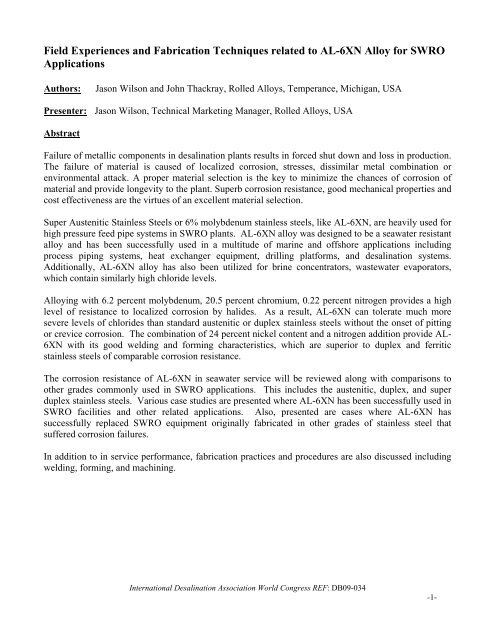
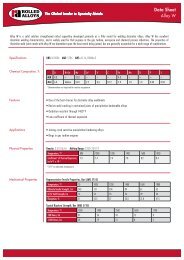
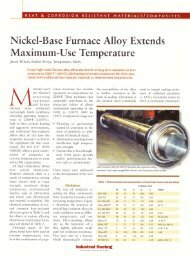
![RA333 Data Sheet [Heat Resistant Alloys] - Rolled Alloys](https://img.yumpu.com/50335849/1/190x245/ra333-data-sheet-heat-resistant-alloys-rolled-alloys.jpg?quality=85)
